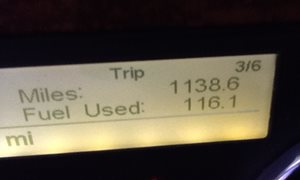Beware the Small Sample Size
A few weeks ago I fueled up in Sheboygan, WI. It was about 70 miles to my customer in Green Bay. I decided to leave the current tank information on my dash screen. The first few miles have a couple of rolling hills. The MPG swings were huge. Obvioulsy going downhill my MPG was off the chart. Uphill MPG was really bad. The newer the tank the bigger the swing. At some points my tank was over 11 MPG. At other points it was about 4. The large swings made me think about sample size.
The larger the sample size the smaller the margin for error. I remember talking to a fleet owner about data gathering. He also has a mathematical backgorund. So, we were talking numbers. At the time we were talking about trailer skirts, which were not as prevelant as they are now. He is a data driven manager. His fleet is somewhere north of 100 trucks. He shares data with a distant fleet to lower the margin for error. By working with the other fleet he doubles his sample size and decreases the margin of error.
 One truck owner operators like me are constantly trying to maximize profitability .Lowering fuel costs is a major component of profitability. Yes, constantly keep data. See where your truck runs the best for you. Think about that fleet owner who thought that the margin of error for 100 trucks was too large and sought to reduce it.Use data from other trucks. Read the torque charts for your engine. Look at what the engineers are using on super truck projects. Think outside of your one truck.
One truck owner operators like me are constantly trying to maximize profitability .Lowering fuel costs is a major component of profitability. Yes, constantly keep data. See where your truck runs the best for you. Think about that fleet owner who thought that the margin of error for 100 trucks was too large and sought to reduce it.Use data from other trucks. Read the torque charts for your engine. Look at what the engineers are using on super truck projects. Think outside of your one truck.
At some show, I fully expect to have someone come up and tell me that they increased their MPG by 5% when they tied a dozen tin cans to the bumper. Logic tells you that tying tin cans to your bumper does not improve MPG. If anythin it would increase you drag coefficient. Yet, that driver may be right. We all like to be right. Perhaps they changed a few driving habits to increase MPG, or maybe they had a tailwind that day. In a smallsample size we can make just about anything work.
All trucks and I qoute Detroit rep Mike Adamcewski, a little "drinky" at some point. My 2013 DD15 had a drinky point at about 1400 RPM. If you look at the torque chart for that engine, you would see that there is a significant drop in the chart at about 1400 RPM. My personal experience was backed up by enginnering information. Use whatever legitimate information you can find. See where your engine is designed to run. Set your truck up so that your operation naturally runs in the sweet spot.
This business is hard. Don't make it harder on yourself by trying to prove a point. Increase your data base whenever possible. Learn from others. Follow fundamentals. Lower your idle time. Drive as fast as you need to, not as fast as you want to.Keep the left door shut. Increase your following distance. Make it easier on your truck and you will make it easier on yourself.